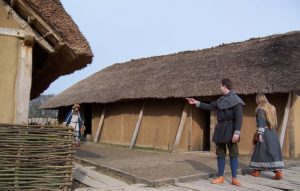The Viking Settlement of Hedeby was a hugely significant site at the height of the Viking Era. Archaeological evidence has provided us with many clues about its size and the nature of life there. We also have the benefit of a contemporary account of Hedeby at its peak. This far from flattering account comes from an Islamic Merchant. Al Tarsushi travelled to Hedeby from Moor held Cordoba in Spain. His travels are illustrative of how well connected the world was at this period and provides evidence that it was not just the Vikings who made sea journeys for long-distance trade.

Description of Hedeby as written by Al Tarsushi
“Slesvig (Hedeby) is a very large town at the extreme end of the world ocean…. The inhabitants worship Sirius, except for a minority of Christians who have a church of their own there…. He who slaughters a sacrificial animal puts up poles at the door to his courtyard and impales the animal on them, be it a piece of cattle, a ram, billygoat or a pig so that his neighbours will be aware that he is making a sacrifice in honour of his god. The town is poor in goods and riches. People eat mainly fish which exist in abundance. Babies are thrown into the sea for reasons of economy. The right to divorce belongs to the women…. Artificial eye make-up is another peculiarity; when they wear it their beauty never disappears, indeed it is enhanced in both men and women. Further: Never did I hear singing fouler than that of these people, it is a rumbling emanating from their throats, similar to that of a dog but even more bestial.”
The BBC has an interesting time travellers guide to Hedeby. It is quite accessible and may be appropriate reading material for some Key Stage Two pupils. You can access it here.
Do you want to find other Primary Sources for use in your lessons, or for research purposes? Visit our Primary Sources page to see which areas we currently have a range of sources for.